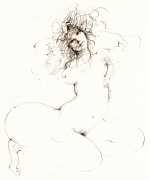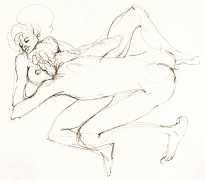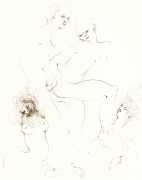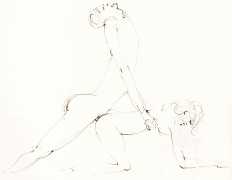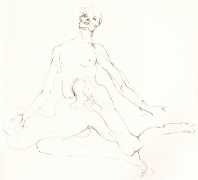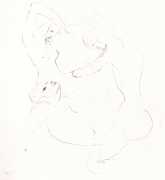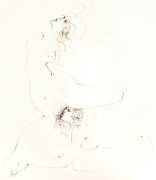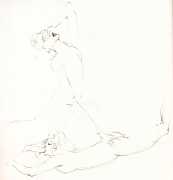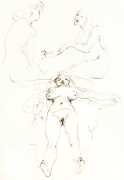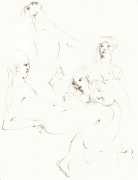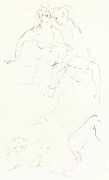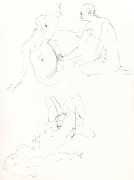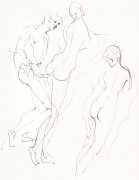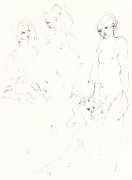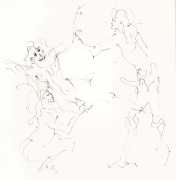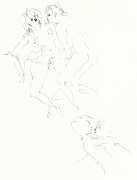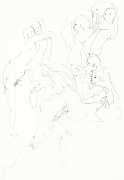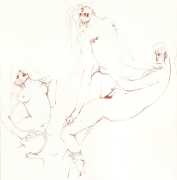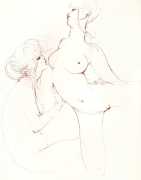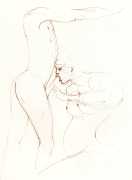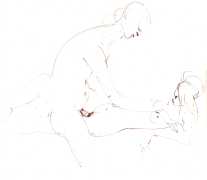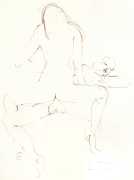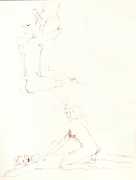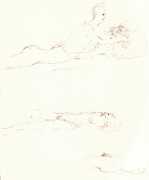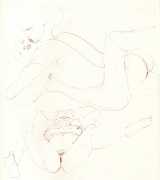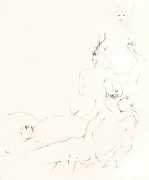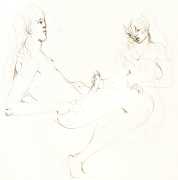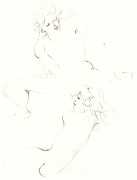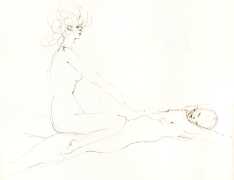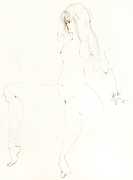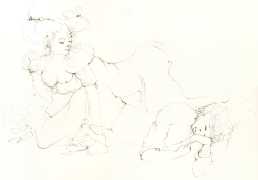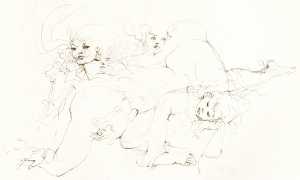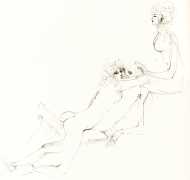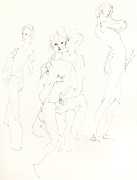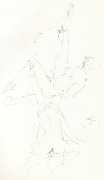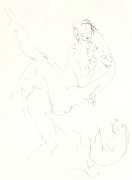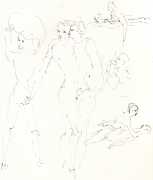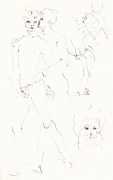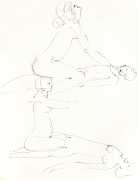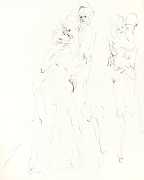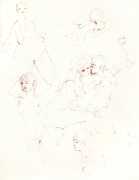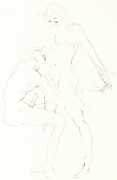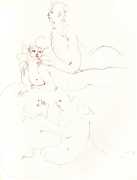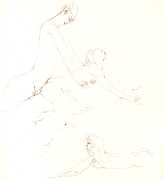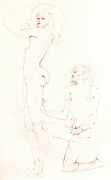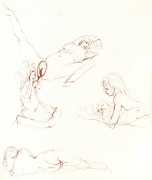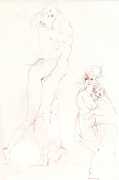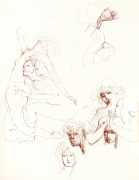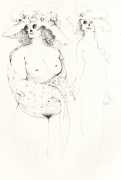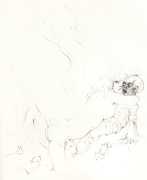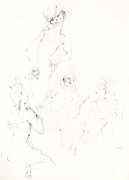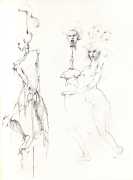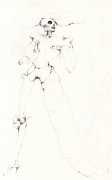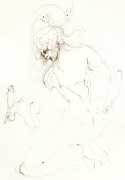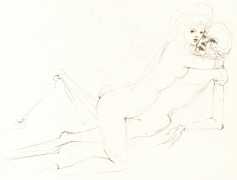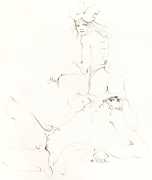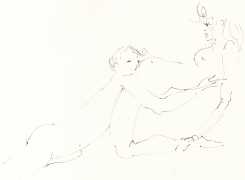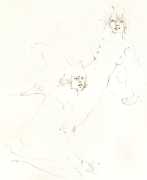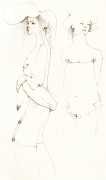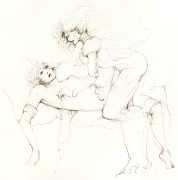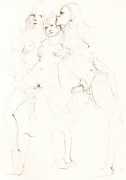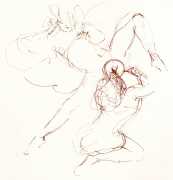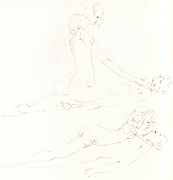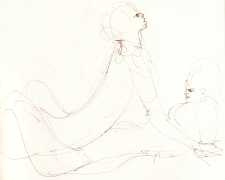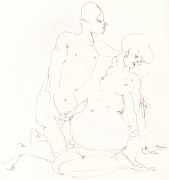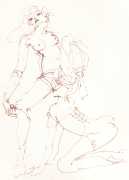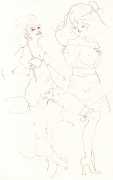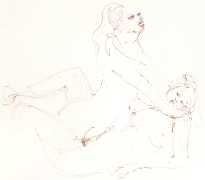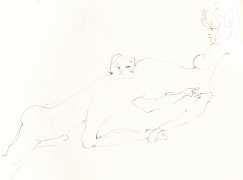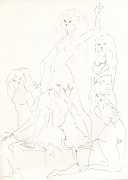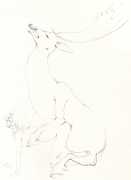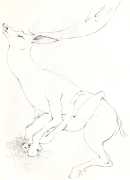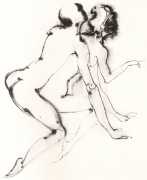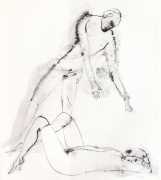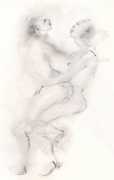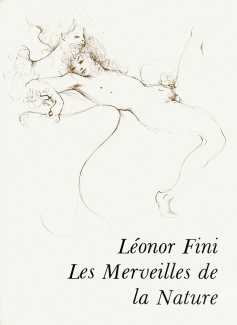 Les merveilles de la nature (The Marvels of Nature) is the much more appropriate title of the collection of drawings which was also published in a German edition with the title Schöne Liebe der Hexen (The Beautiful Love of Witches). The eighty fine ink drawings were made during and after Leonor Fini’s tempestuous affair with married Paris businessman Paul Henri, and are the most explicitly sexual drawings she ever made – as she approached her sixtieth birthday she was very aware both of the power of sexual desire and passion, and of the ever shorter time she had left to experience all of her sexual fantasies.
Les merveilles de la nature (The Marvels of Nature) is the much more appropriate title of the collection of drawings which was also published in a German edition with the title Schöne Liebe der Hexen (The Beautiful Love of Witches). The eighty fine ink drawings were made during and after Leonor Fini’s tempestuous affair with married Paris businessman Paul Henri, and are the most explicitly sexual drawings she ever made – as she approached her sixtieth birthday she was very aware both of the power of sexual desire and passion, and of the ever shorter time she had left to experience all of her sexual fantasies.
The French edition of these drawings was sponsored and championed by Fini’s friend and co-conspirator Jean-Jacques Pauvert (1926–2014), who is probably best known for publishing the work of the Marquis de Sade in the early 1950s and as the first publisher of Histoire d’O (The Story of O) in 1954.
Where the German collection has a lengthy and rather tedious introduction by Karl Heinz Kramberg, of which both Fini and Pauvert were dismissive, the French edition starts with a poem by the Cuban writer Severo Sarduy entitled ‘Léonor Fini’, an intelligent and insightful homage to his artist friend. It includes poignant references to Leonor’s Burmese cats, her love of colourful glassware, her different personae, and the permanence of true love.
We include Sarduy’s admiring commendation in full, both in English and in the original French.
Les merveilles de la nature was published jointly by Jean-Jacques Pauvert and Karl Heinz Kramberg, bound in red with a matching red slipcase. There was a limited numbered quantity of 100 which included a print signed by Fini.
Léonor Fini
Severo Sarduy
 Severo Sarduy (1937–93) was a Cuban poet, author, playwright, and critic of Cuban literature and art. Some of his works deal explicitly with male homosexuality and transvestism. Born in a working-class family of Spanish, African, and Chinese heritage, Sarduy was the top student in his high school in Camagüey, and in 1956 moved to Havana, where he began a study of medicine. With the triumph of the Cuban revolution he collaborated with the Diario libre and Lunes de revolución, pro-Marxist papers. In 1960 he travelled to Paris to study at the Ecole du Louvre. There he was connected to the group of intellectuals who produced the magazine Tel quel (As Is), particularly to philosopher François Wahl, with whom he was openly involved. Sarduy worked as a reader for Editions du Seuil and as editor and producer of the Radiodiffusion-Télévision Française. He decided not to return to Cuba when his scholarship ran out a year later. Disaffected with Castro’s regime and fearful of its persecution of homosexuals and the censorship imposed on writers, Sarduy never went home.
Severo Sarduy (1937–93) was a Cuban poet, author, playwright, and critic of Cuban literature and art. Some of his works deal explicitly with male homosexuality and transvestism. Born in a working-class family of Spanish, African, and Chinese heritage, Sarduy was the top student in his high school in Camagüey, and in 1956 moved to Havana, where he began a study of medicine. With the triumph of the Cuban revolution he collaborated with the Diario libre and Lunes de revolución, pro-Marxist papers. In 1960 he travelled to Paris to study at the Ecole du Louvre. There he was connected to the group of intellectuals who produced the magazine Tel quel (As Is), particularly to philosopher François Wahl, with whom he was openly involved. Sarduy worked as a reader for Editions du Seuil and as editor and producer of the Radiodiffusion-Télévision Française. He decided not to return to Cuba when his scholarship ran out a year later. Disaffected with Castro’s regime and fearful of its persecution of homosexuals and the censorship imposed on writers, Sarduy never went home.
I The Model
Come.
Come closer.
Don’t be afraid.
Predictable symmetry: one day it will be you who will invite, you who will regulate sequences and gestures.
In a bowl mounted with dragonflies, there will be fruits with skin so thin that one would think the liquor was ready to burst out.
Wearing an orange headdress,
naked,
you get off a train,
flowers in your arms.
A tiger flees among the rushes:
lacquered in red,
sealed in black,
numbers and seals.
II Great Mandala of Peaceful Cats
Not without flaws – if they die –
Colomba, work of a calligrapher creating autumn grasses,
Marmifome, Calderonian, fluidly sententious,
Sara, complete prima ballerina, tangling the cords of a cardinal’s hat,
Ganeça, who knows the names of all the stars,
Belinda, cat of brocades,
Trilby, cat of ruins,
Vibrissa, a bamboo, a winter plum tree, a spot of white ink on a palm leaf,
Rinfignine, who comes out in autumn, when the constellations of the west rise in the night sky,
Urbino, who once gave birth to a castrated Jacobin.
III Anatomy Lesson
On a green table, clean as a sink, head on the wood: the corpse of a young woman with her mouth open, toothless, an empty stomach, swollen eyes, spherules divided by black grooves.
Near the body lay five girls, also grey and wearing lace wide-brimmed hats trimmed with yellow flowers. One of them had folded down the wings of her hat – only her lips could be seen – another had raised them, and showed her face, snobbish.
Smaller than the others, a sour soul sewn into her tulle embroidered with scales, snakeskin, under her oversized bonnet, with strawberry seaweed, her chin resting in her hand, elbow resting on the stiffened corpse, opened her mouth: This is the Man, she said, discreet but mocking: this little pile. His skull a chest, his belly an amphora. On this swollen liver, on these viscera, enormous white butterflies will come to rest.
The one who had raised the wings of her hat:
Scorpions will nest in our ears.
Crows will cover our frozen bodies.
Mushrooms will grow in our eye sockets.
Snakes will enter our anus.
The sour one, chanting:
With a small spoon
they will scrape our eyes,
stubborn oysters
that the monkeys will gobble.
The one who had lowered the wings of her hat:
See:
useless, the virtuosity of dissection,
the formalin gloves,
the coroner’s cough,
the cocoons in the palate,
useless, the pins of the shroud.
They remain looking at their feet,
Cartesian,
the dead.
And through the window of the morgue, they looked at the street: passers-by barely advancing in the mist.
Higher up, between the ceramic scrolls, on the cornice of a church, a peacock perches.
In the distance,
on a promontory,
the castle of Maximilian of Austria;
further still,
near the sea,
a sphinx.
IV Distant Relative
The same bare table.
The same girls.
On the ground, a dark green crust that thickens to form yellowish, grainy tufts with white edges; on the mauve walls a grey lichen, rings of black leprosy, microscopic flowers; signs of rust etch the vault, traced in saffron.
You, golden, serene on the scaffold.
You are the sphinx of the port: the saltpetre gnaws at you: also the claws.
At the bottom of a lava corridor
– furious shadows –
you decipher
the flight of birds,
and, in the sealed centre,
in the ellipse of the sun,
the text.
V Brocades and Bloody Skeletons
Feast: the round of the living and the dead. Wheel of toothless queens.
Rising out of a soft marble,
without veins or cracks,
the awakened gather for grace.
On the white grass
sugar skeletons
strum their sand guitars.
We will adorn you:
your forehead with Flavian flowers,
your cheeks with starry polygons,
your lips with our signatures,
your coat adorned with herons.
Come.
Come closer.
Do not be afraid.
My sex is the largest: I will enter you: I will be a stag.
You will be subjected
to a ritual
whose rigour is the only meaning:
a child
will spell out the papyrus.
Dried blood background:
you will bring the offerings.
A young servant
will reveal the object in the basket.
Dry rustling.
White spread wings:
the demon will strike the sense.
The obese has drunk.
The evil one has shown their mask.
To the sound of cymbals,
a bacchante dances.
You will be examined:
we will slide our fingers
– sharpened gauntlets –
To open them, in the corners of your lips,
with the stem of our brushes
we will unbridle your eyelids,
with a magnifying glass
we will scrutinise your anus.
VI To Be Forgotten
At the limits of the curvilinear space that we assign to you:
Guimard, vegetal ogives,
Tiffany, iridescent metals: peacock feathers,
Gaudi, turrets with fruits set in ceramic,
Lalique, opal vases where two butterflies land,
Horta, corollas of tortoiseshells, arabesques with coppery reflections,
De Fëure, poppy stems, Algerian alabaster,
Gallé, pyxis veined with onyx,
Hennebique, tufts of mistletoe falling from a minaret.
Breaking of the screens. Armchairs of rosewood and leather.
Stools inlaid with mother-of-pearl. Cushions filled with pearls.
In the centre
– frame for your dusted face –,
the throne of flames
on whose back
antipodean lovers
ascend, jaguar, a sun,
descend, white dwarf, a moon.
VII The Tattoo Room
The white room.
Above the oranges,
hard,
the hanged men swing,
stained with ash.
Raucous orchestra.
Before them,
naked,
contemplating them,
we dance.
The marks of the party will remain inscribed on the ground,
and in the mosaics of red stone
the trace of the golden faces.
Erasing the landscape of the background,
blurring the figures,
the humidity will mist the fresco.
VIII From Love to Death
What friend more faithful
would follow you to the ashes of meaning?
My hair around your skull,
my gaze in your empty eye sockets,
my lips stuck to your jaws,
my tongue between your floating teeth, clacking in their sockets,
my breasts against your ribs,
my sex in the emptiness of your hips,
my knees against your kneecaps, by the bones of your feet
my feet shackled.
Come.
Come closer.
Again.
Don’t be afraid.
And here is the poem in the original French:
Léonor Fini
Severo Sarduy
I Le modèle
Viens.
Approche.
N’aie crainte.
Prévisible symétrie: un jour ce sera toi qui inviteras, toi qui règleras séquences et gestes.
Dans une coupe montée de libellules, il y aura des fruits à la peau si fine qu’on croirait la liqueur prête d’en déborder.
Coiffée d’orange,
nue,
tu descends d’un train,
des fleurs entre les bras.
Un tigre fuit parmi les joncs:
laqué de rouge,
cacheté de noir,
chiffres et sceaux.
II Grand Mandala des chats paisibles
Pas sans défaut – s’ils meurent –:
Colomba, oeuvre d’un calligraphe pousse-d’herbe-d’automne,
Marmifome, caldéronien, fluidement sentencieux,
Sara, prima ballerina assoluta, emmêlant les cordons d’un chapeau de cardinal,
Ganeça, qui connaît le nom de toutes les étoiles,
Belinda, chat de brocarts,
Trilby, chat de ruines,
Vibrissa, un bambou, un prunier d’hiver, une tache d’encre blanche sur une feuille de palmier,
Rinfignine, qui sort en automne, lorsque les constellations du cadran occidental montent au ciel nocturne,
Urbino, qu’accoucha jadis un jacobin châtré.
III Leçon d’anatomie
Sur une table verte, nette comme un évier, la tête sur le bois: le cadavre d’une jeune bouche ouverte, édenté: ventre vidé, yeux gonflés, sphérules divisées par des rainures noires.
Près du corps étendu cinq filles également grises et coiffées de capelines de dentelles ponctuées de fleurs jaunes. Une d’elles avait rabattu les ailes du chapeau – on ne voyait que ses lèvres –, une autre les avait relevées, et montrait son visage, snob.
Plus petite que les autres, une aigrelette, cousue dans son tulle brodé d’écailles, peau de serpent, sous son bonnet démesuré, d’algues fraises, menton machinalement dans la main, coude appuyé sur le cadavre roidi, ouvrait la bouche:
– Ceci est l’Homme – dit-elle, discrète mais moqueuse – : ce petit tas. Son crâne: un coffre, son ventre: une amphore. Sur ce foie gonflé, sur ces viscères, d’énormes papillons blancs viendront se poser.
Celle qui avait relevé les ailes de son chapeau:
Des scorpions nicheront dans nos oreilles.
Des corbeaux couvriront nos piecls glacés.
Des champignons pousseront dans nos orbites.
Des serpents nous entreront dans l’anus.
L’aigrelette, en psalmodiant:
Avec une petite cuiller
on nous râclera les yeux,
huîtres opiniâtres
que les singes goberont.
Celle qui avait rabattu les ailes de son chapeau:
Voyez:
inutile, la virtuosité de la dissection,
les gants-formol,
la toux du légîste,
les cocons dans le palais,
inutiles, les épingles du linceul.
Ils restent à se regarder les pieds,
cartésiens,
les morts.
Et par la fenêtre de la morgue, elles regardèrent la rue: les passants avançant à peine dans la brume.
Plus haut, entre les volutes de céramique, sur la corniche d’une église, un paon posé.
Au loin,
sur un promontoire,
le château de Maximilien d’Autriche;
plus loin encore,
près de la mer,
un sphynx.
IV Parente lointaine
La même table nue.
Les mêmes filles.
Sur le sol, une croûte .vert sombre qui s’épaissit pour farmer des touffes jaunâtres, granuleuses, aux rebords blancs; sur les murs mauves, un lichen gris, cernes de lèpre noire, fleurs microscopiques; des signes de rouille raient la voûte, tracés au safran.
Toi, d’or, sereine sur l’échafaud.
Tu es le sphynx du port: le salpêtre te ronge: déjà les griffes.
Au fond d’un couloir de lave
– ombres furieuses –,
tu déchiffres
le vol des oiseaux,
et, au centre scellé,
dans l’ellipse du soleil,
le texte.
V Brocards et squelettes sanglants
Fête: ronde des vivants et des morts. Roue de reines édentées.
Se hissant hors d’un marbre mou,
sans veines ni brisures,
les éveillées se groupent en Grâces.
Sur l’herbe blanche
des squelettes en sucre
grattent leurs guitares de sable.
Nous te parerons:
le front de fleurs flaviennes,
les joues de polygones étoilés,
les lèvres de nos signatures,
d’hérons dédoublés ton manteau.
Viens.
Approche.
N’aie crainte.
Mon sexe est le plus grand: j’entrerai en toi: je serai cerf.
Tu seras soumise
à un rituel
dont la rigueur est le seul sens:
un enfant
épellera le papyrus.
Fond de sang séché:
tu apporteras les offrandes.
Une jeune servante
dévoilera l’objet dans la corbeille.
Bruissement sec.
Blanc déployé des ailes:
le dèmon frappera le sens.
L’obèse a bu.
Le malin a montré le masque.
Au son des cymbales,
une bacchante danse.
Tu seras examinée:
nous glisserons nos doigts
– gantelets aiguisés –
Pour les ouvrir, dans les commissures de tes lèvres,
avec la tige de nos pinceaux
nous débriderons tes paupières,
avec une loupe
nous scruterons ton anus.
VI Pour y être oubliée
Aux limites de l’espace curviligne que nous t’assignons:
Guimard, ogives végétales,
Tiffany, métaux irisés: plumes de paon,
Gaudi, tourelles aux fruits sertis de céramique,
Lalique, vases d’opale où se posent deux papillons,
Horta, corolles d’écailles, arabesques aux reflets cuivrés,
De Fëure, tiges de pavot, albâtre d’Algérie,
Gallé, pyxide veinée d’onyx,
Hennebique, touffes de gui tombant d’un minaret.
Brisure des paravents. Fauteuils de palissandre et de cuir.
Tabourets incrustés de nacre. Coussins garnis de perles.
Au centre
– cadre pour ton visage enfariné –,
le trône de flammes
au dossier duquel
amants antipodes
monte, jaguar, un soleil,
descend, naine blanche, une lune.
VII La chambre de tatouages
La chambre blanche.
Au-dessus des oranges,
bandant,
les pendus se balancent,
tachés de cendre.
Orchestre rauque.
Devant eux,
nues,
les contemplant,
nous dansons.
Les marques de la fête resteront inscrites sur le sol,
et dans les mosaïques de pierre rouge
la trace des visages d’or.
Effaçant le paysage du fond,
estompant les figures,
l’humidité signera la fresque.
VIII Amor à mort
Quel ami plus fidèle
te suivrait jusqu’à la cendre du sens?
Mes cheveux autour de ton crâne,
mon regard dans tes orbites vides,
mes lèvres collées à tes maxillaires,
ma langue entre tes dents flottantes,
claquant dans leurs alvéoles,
mes seins contre tes côtes,
mon sexe dans le vide de tes hanches,
mes genoux contre tes rotules,
par les os de tes pieds
mes pieds entravés.
Viens.
Approche.
Encore.
N’aie crainte.


